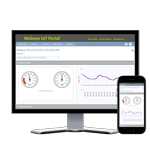Life-saving medical devices deserve double security. In addition to built-in protection functions and audible fault indications, extra supervision is recommended. The Mobeye PowerGuard (CM4100) fulfills this additional monitoring.
If local alarms on a medical device are not possible or sufficient, the Mobeye PowerGuard brings the solution. It will “read out” the alarm and transmit it via mobile phone to contact persons that have been set up or to an emergency room.
Examples are the triggering of an epilepsy alarm, the transmission of panic reports, a bed weighing system, the opening of an AED cabinet, checks on ventilation equipment, etc. The contact persons are alerted by app notification, call, SMS and / or e-mail.

For a medical device with a (potential-free) fault output, the Mobeye PowerGuard functions as an alarm detector in the event of a fault. The two potential-free inputs are adjustable as NO or NC contact. With settings such as alarm delay and freely definable alarm texts, the Mobeye PowerGuard provides reliable monitoring of the functioning of the equipment.
The power supply is continuously monitored. An alarm will follow as soon as there is a power failure. Monitoring is done by plugging the supplied mains adapter into the same socket as the medical device, or directly to a 12/24VDC output. The alarm consists of app push messages, telephone calls, SMS notifications, e-mails or a report to an emergency room.
The PowerGuard has an internal communication module for the mobile network. This makes the transmission of the alarm independent of the local infrastructure. In addition, the batteries will take over in the event of a power failure. As a result, it also functions as a backup system for local calling systems. Double monitoring for vital functions.
![]() Download the info “Monitoring of medical devices”
Download the info “Monitoring of medical devices”
![]() Go to the product page Mobeye CM4100
Go to the product page Mobeye CM4100